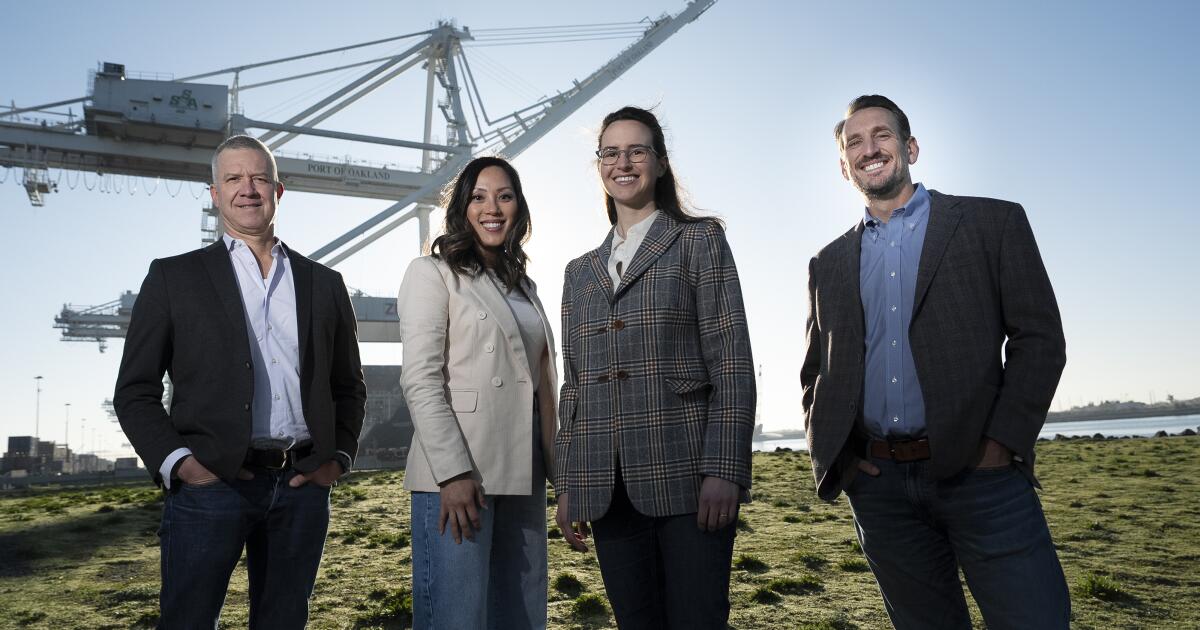It seemed like the death knell. The state of California failed to get required federal permission from the Biden administration — the Biden administration — to enforce new regulations that would phase out sales of diesel big-rig trucks to fleet operators at the state’s seaports, forcing them to buy zero-emission vehicles instead.
The regulations, known as Advanced Clean Fleets, faced pitched opposition from the trucking industry. But California plans to carry on anyway, hoping the carrot of subsidy money and the stick of other state regulations will accomplish its goals.
Infrastructure improvements will help. Liane Randolph, chair of the California Air Resources Board, was among officials on hand at the Port of Long Beach recently for a ribbon-cutting ceremony for a new electric truck charging depot — 25 chargers and 44 dispensers to serve up to 200 trucks a day.
“We are committed in California to continuing this process,” she said.
The $10-million-plus depot, funded through a mix of private investment and state, local and federal tax credits, subsidies and grants, will be run by a San Francisco startup called Forum Mobility, one of several heavy-duty truck charging companies seeking a foothold in a new business category called TaaS, or trucking as a service.
Forum charges truck fleet operators monthly “subscriptions” to use its charging depots. It also buys or leases electric trucks, in turn leasing them to truck fleet owners as part of a subscription package.
The success (or not) of companies such as Forum could determine whether California achieves its ambitious quest to slash local pollution and global greenhouse gas emissions by converting the state’s massive population of diesel trucks to zero-emission versions.
By January, the Biden administration’s Environmental Protection Agency had not acted on California’s 15-month-old request for a waiver to federal rules that would allow Advanced Clean Trucks rules to move forward. CARB withdrew its waiver request in January for fear the Trump administration would turn it down. Biden’s EPA never explained what was taking so long to reach a decision.
The rule would have applied to drayage trucks — semitrucks that haul shipping containers into and out of seaports. The goods are carried to nearby distribution centers, most of which are then transported by long-distance trucks and trains.
Because drayage trucks concentrate fume-pumping diesel engines in a tight location, the air quality in residential areas adjacent to ports suffers. To combat this pollution and global warming, the state is pushing for electric vehicle transport.
The rules would have applied to any truck operator who owned or leased between one and 50 trucks, if annual revenue topped $50 million, or to any truck fleet larger than 50 vehicles.
Forum Mobility electric trucks from Volvo, charging up.
(Kevin Krause / Forum Mobility)
Forum and other electric truck service providers aren’t panicking. While the state cannot now force fleet operators to buy electric trucks, it can still require truck manufacturers to sell them through its Advanced Clean Trucks regulations.
It’s similar to California’s Advanced Clean Cars program, which doesn’t require consumers to buy electric vehicles, but penalizes manufacturers if they don’t phase out sales of gasoline and diesel cars and light trucks by 2035. Truck manufacturers have until 2036 to fully convert to zero-emission sales of new trucks.
Most major U.S. big-rig truck and engine manufacturers signed a deal with the state in 2023, agreeing to go along with the plan and not file lawsuits against it, in return for more regulatory certainty — at least at the state level — and flexibility in meeting the state’s strict diesel pollution rule. That deal could protect the program from any action against it from the Trump administration. Signers include Ford, GM, Navistar, Volvo, Paccar, Cummins and others.
But with no state rules forcing zero-emission trucks on truck buyers, the budding electric truck industry will have to rely more on salesmanship — operating costs are cheaper for electric trucks — and more on government subsidy money to pay for the currently enormous costs of electric trucks.
“We’ll move forward with more carrots than sticks,” said Adam Browning, policy chief at Forum Mobility.
Truckloads of carrots will be required, and they’ll have to come from state and local governments, because federal support for electric trucks appears doubtful in the Trump administration.
By far the biggest barrier to diesel-to-electric conversion is the cost of electric trucks. Few electric big-rig assembly lines yet exist and an electric big-rig cab can cost up to three times as much as a diesel version — around $450,000.
Scaling up production — in a big way — could result in great cost reductions. State officials thought a diesel ban combined with state subsidies would sufficiently boost demand. Now it’ll have to rely mostly on subsidies.
How much the state will pay out is unclear, hinging partly on demand and partly on how much state revenue is available. CARB said it has paid $1.5 billion to subsidize purchase of commercial electric trucks, nearly $200 million last year alone.
Buyers can qualify for subsidies worth from 40% to 90% of the cost of an electric big-rig cab.
The state believes the cost is worth it in the long run, with reduced pollution improving public health and lowering medical costs, and greenhouse gas reduction helping to address hazards partly attributable to global warming. If left purely to the marketplace, any shift to zero-emission vehicles would take much longer than the state believes is necessary.
There are many sources of subsidy money in California for trucks and truck charging, including two carbon cap-and-trade programs, the Greenhouse Gas Reduction Fund and the Low Carbon Fuel Standard. Money is also available from CARB, from state air quality districts, from cities and from container fees levied by port operators.
With enough demand, truck manufacturers will scale up and add production lines, sending costs down. If the cost ever becomes competitive with diesel trucks, truck fleet owners, especially those with short- to medium-haul routes, may well find electric trucks more appealing.
Rudy Diaz is an early adopter. He owns Hight Logistics, a medium-size fleet operator for trucks that transfer freight in and out of the ports of Long Beach and Los Angeles. His drayage trucks are natural candidates for electric early adoption. With a typical range around 200 miles, heavy truck batteries don’t yet have the range to meet the demands of long-haul transport. But it’s plenty for most drayage jobs.

Rudy Diaz, chief executive at Hight Logistics, with an electric truck at Hight headquarters in Long Beach.
(William Liang / For The Times)
Diaz grew up in Watts and worked in freight logistics before launching Hight from his house with a small fleet of diesel cabs. Hight now operates a warehouse and truck yard near the Long Beach airport, with 70 trucks — 50 diesel, 20 electric. He’s hoping to grow the electric share.
He’s been a customer of Forum Mobility since December 2021.
“Forum reached out to me saying they were a startup company and wanted to start a program with turnkey solutions” — truck leasing, maintenance and charging, including chargers installed at the Hight truck yard.
“At the time I had no idea what a battery-electric truck was or even how you’d charge one,” he said.
But he’s an outdoors lover, a bicyclist, trim and fit, with a personal dedication to improving air quality.
“I genuinely do care about the environment,” he said. “If the environment is not considered, our survival is in question.”
Subsidies from state, local and federal sources flow through to Forum and Hight, allowing Diaz’s electric trucks — from Volvo, Daimler and BYD — to make a profit. But no question, he said, the electric truck market will have to stand on its own at some point to attract sufficient private capital and grow big enough to displace diesel technology.
Hight carries everything from clothes to car parts to consumer electronics, but the electric trucks are allowing it to branch out. The EV component was key to Hight’s getting a freight contract with Lime Micromobility, the electric scooter company.
“Decarbonization of the economy underpins everything we do,” said Lime co-founder Adam Savage. “We want to go carbon free as fast and aggressively as we can, whether producing our own vehicles our moving freight.”
One of Hight’s drivers, Marco Garrido of Anaheim, recently shifted from diesel to electric, and became an instant convert.
“I love it, I love it,” he said. The trucks are quiet, no exhaust, no cumbersome gear shifting, and the new models are fitted with the latest safety equipment, including backup sensors. It adds up, he said, to less stress.
Although it’s highly questionable whether federal money makes its way to the nascent electric truck market over the next four years, a nonprofit financial group called Climate United last August locked in nearly $7 billion in funding from the EPA to help for clean energy projects, part of which will be spent to boost truck maker production and pave the way for private lenders now stuck in neutral.
One way to do that: create a market in used electric trucks. Not only are electric trucks expensive, no one knows how much they’ll be worth once their leases run out.
“Traditional lessors are not set up to take risk on what that amount will be,” said Jacqueline Torres, head of finance at Forum.
That can scare private finance away, said Brooke Durham, the organization’s communications director. With the EPA money, it will buy trucks and lease them to Forum and other trucking-as-service companies, taking on the risk of creating a used truck market. As used truck prices become clearer, private lenders and investors will have hard data on which to base their financial decisions.
“This will be catalytic to have private capital step in,” said Forum Mobility Chief Executive Matt LeDucq.
The company is hoping that’ll help spark big new orders.
“Something needs to break the chicken or the egg loose,” said Forum’s Browning. “Once a 500-truck order comes in, the flywheel really gets going.”
California’s clean transportation goals depend on that happening.

